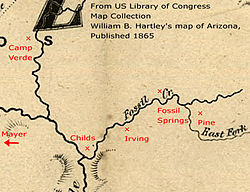- Childs-Irving Hydroelectric Facilities
-
Childs--Irving Hydroelectric Facilities
 A map showing the locations of Fossil Creek and the Childs-Irving power plants
A map showing the locations of Fossil Creek and the Childs-Irving power plantsLocation: Yavapai County, Arizona, USA Nearest city: Camp Verde, Arizona Coordinates: 34°20′59″N 111°41′57″W / 34.34972°N 111.69917°WCoordinates: 34°20′59″N 111°41′57″W / 34.34972°N 111.69917°W Built: 1909 Architect: Unknown Architectural style: No Style Listed Governing body: Private NRHP Reference#: 91001023
[1]Added to NRHP: August 09, 1991 Childs-Irving Hydroelectric Facilities is a power-generating dam in Arizona.
Contents
History
The water rights of Fossil Creek, located between Pine/Strawberry and Camp Verde, Arizona, were purchased in 1900 by rancher Lew Turner. His goal was to generate hydroelectric power for sale to mining communities in the Bradshaw Mountains and Black Hills in Yavapai County, such as Jerome, Clarkdale, Crown King and many others.
Arizona Power Company began construction of the Childs power plant in 1908. Because the land around Fossil Creek consists mainly of mountainous terrain and canyons, and the nearest railroad station was located in Mayer, Arizona, more than 400 mules and 600 men were used to pull over 150 wagons along the 40-mile (64 km) wagon trail. Other than the foreman and timekeeper, all of the workers were Apache and Mojave Indians, working for $2 per day. Once construction of the flume began, 120 to 150 feet (46 m) were constructed on a daily basis, costing around $100 per day.
The Childs plant, located near the Verde River outlet of Fossil Creek. The Irving plant, located halfway between Childs and the Fossil Springs source, was constructed in 1916. The system of canyons and steep falls from the spring source to the Verde River outlet provided an ideal location for a hydroelectric plant. The constant flow of 43 cubic feet per second was also a factor in powering the plants through Fossil Springs. Once completed, the Childs plant produced 2.8 megawatts of electrical power.
When the Childs plant was built by the Arizona Power Company in 1908, they raised money through investment bonds sold by William Bonbright and Company. The Childs Plant was named for S. W. Childs, the Bonbright Company's bond-broker. The Irving plant was named for Irving Bonbright, a co-founder of the Bonbright Company. The reservoir known as Stehr Lake was named for Frederick W. Stehr, treasurer of the Arizona Power Company.
In 1999, after consideration and negotiation with environmental and community stakeholders, Arizona Public Service announced it had decided to decommission the Childs-Irving plant and restore full flow of Fossil Creek’s waters to its stream bed. APS felt that because of the stream’s unique qualities, decommissioning the plant was a rare opportunity to return the area to its original condition. The benefits to the public associated with restoring this unique stream to its natural flowing state outweighed the business benefits the facility provided APS.[2]
The flume and tunnels
The first stage of development included a flume and tunnels made of concrete.
Stehr Lake
Between the Irving and Childs plants, the spring water exited the flume and tunnels and entered an artificial reservoir, Stehr Lake. Stehr Lake was built to create a backup water supply in case of low volume.
Fossil Springs and Creek was so named due to the large amount of calcium in the water, causing bone like deposits, or travertine, to form in and around the creek bed.
See also
References
- ^ "National Register Information System". National Register of Historic Places. National Park Service. 2008-04-15. http://nrhp.focus.nps.gov/natreg/docs/All_Data.html.
- ^ http://www.aps.com/aps/CI/Default.html
U.S. National Register of Historic Places Topics Lists by states Alabama • Alaska • Arizona • Arkansas • California • Colorado • Connecticut • Delaware • Florida • Georgia • Hawaii • Idaho • Illinois • Indiana • Iowa • Kansas • Kentucky • Louisiana • Maine • Maryland • Massachusetts • Michigan • Minnesota • Mississippi • Missouri • Montana • Nebraska • Nevada • New Hampshire • New Jersey • New Mexico • New York • North Carolina • North Dakota • Ohio • Oklahoma • Oregon • Pennsylvania • Rhode Island • South Carolina • South Dakota • Tennessee • Texas • Utah • Vermont • Virginia • Washington • West Virginia • Wisconsin • WyomingLists by territories Lists by associated states Other  Category:National Register of Historic Places •
Category:National Register of Historic Places •  Portal:National Register of Historic Places
Portal:National Register of Historic PlacesPower stations in Arizona Coal-fired
generating stationsHydroelectric dams Wind farms Solar thermal plants Nuclear plants Utility companies Arizona Electric Power Cooperative • Arizona Public Service • Salt River Project • Tucson Electric PowerCategories:- Historic districts in Arizona
- 1909 architecture
- Dams in Arizona
- Dams on the National Register of Historic Places
- Hydroelectric power plants in Arizona
- Buildings and structures on the National Register of Historic Places in Arizona
- Buildings and structures in Yavapai County, Arizona
- Mogollon Rim
Wikimedia Foundation. 2010.












